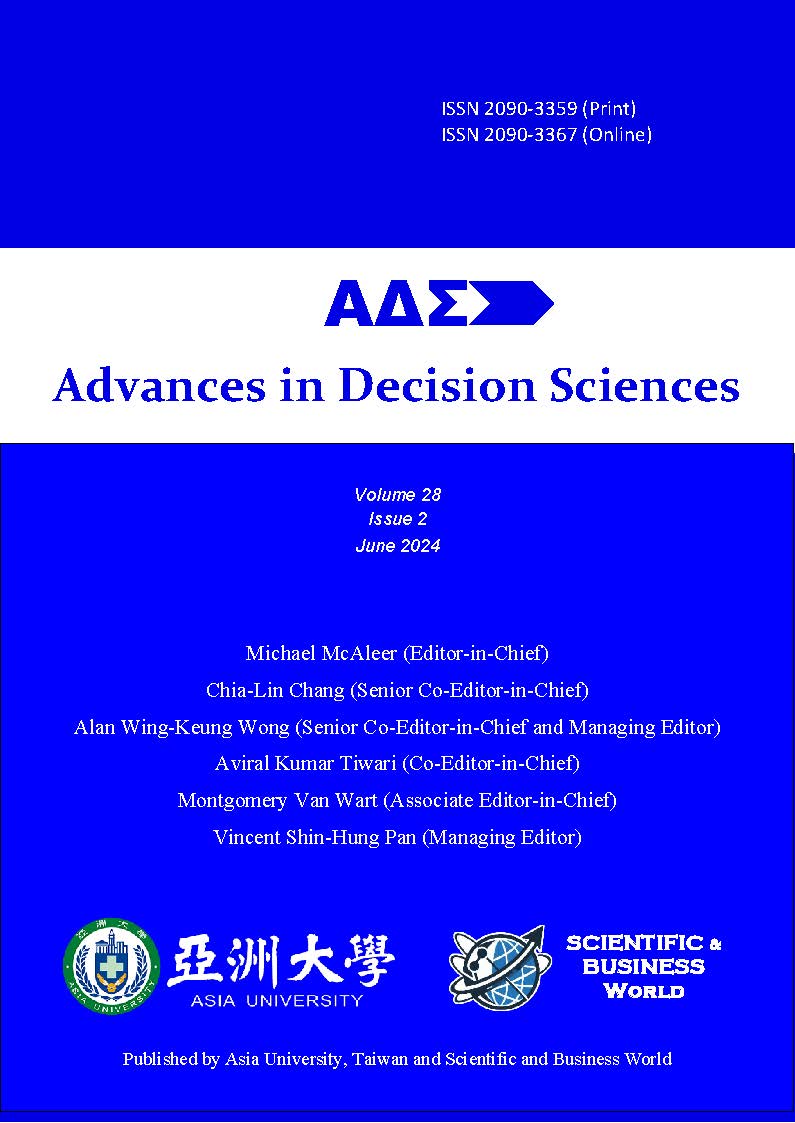Soil Particle Prediction using Spatial Ordinary Logistic Regression
DOI:
https://doi.org/10.47654/v28y2024i2p66-92Keywords:
Soil, Spatial, Logistic RegressionAbstract
Purpose: This study embarks on a novel journey to create a predictive model for soil texture. We utilize the Spatial Ordinary Logistic Regression model to estimate soil particles in the topsoil with unprecedented accuracy. This involves employing Geographically Weighted Ordinary Logistic Regression to analyze and map the spatial distribution of these particles based on primary data collected from the field.
Design/methodology/approach: This study distinguishes itself by adopting a meticulous approach to gathering soil particulate and geospatial data from various random locations. This method is crucial in addressing the complexity of modelling soil texture, an essential aspect of soil management. The study analyzes soil texture, a combination of sand, silt, and clay, using Digital Elevation Model (DEM) data. By leveraging topographical variations, the study predicts soil texture, employing Geographically Weighted Ordinary Logistic Regression for areas without direct observations. This approach significantly enhances both understanding and prediction in soil science.
Findings: The proposed model will be cross-validated to ensure precision. Aimed at aiding land and resource management, this study focuses on examining spatial variations in topsoil particle sizes and their influencing factors. The Geographic Weighted Ordinary Logistic Regression (GWOLR) model, designed for estimating soil particle sizes using a fixed bi-square weight, demonstrated superior effectiveness with a 90% accuracy rate compared to the standard model's 88%. Further findings show that all topographical predictors exhibit significant spatial autocorrelation (Moran’s I, p < 0.05), justifying the spatial approach. The GWOLR model also provides localized parameter estimates, revealing spatial heterogeneity in the influence of terrain features. Specifically, vertical curvature and slope positively associate with sandy textures, while lower northness aspects correlate with higher clay and silt presence. Spatial prediction maps generated from the model align closely with actual field data, affirming its practical value in precision agriculture, land-use planning, and targeted soil conservation strategies.
Practical Implications: In 2023, soil particle size data were gathered from the Kalikonto Watershed Area in Batu City, East Java, Indonesia. This data, divided into three categories, was analyzed using the Geographically Weighted Ordinal Logistic Regression method, incorporating spatial factors.
Originality/value: This study presents innovative methods for enhanced spatial analysis, notably the Geographically Weighted Ordinary Logistic Regression technique. This approach improves spatial and statistical data integration for analyzing geographic information, offering insights into how spatial variables influence soil properties. Focusing on estimating particle-size fractions in the soil's top layer, the research underscores the significance of soil attributes on plant growth and agricultural productivity. Furthermore, it provides new perspectives in the crucial field of soil property investigation.
References
Abidin, M. H. Z., Saad, R., Wijeyesekera, D. C., Ahmad, F., Baharuddin, M. F. T., Tajudin, S. A. A., & Madun, A. (2017). The influences of basic physical properties of clayey silt and silty sand on its laboratory electrical resistivity value in loose and dense conditions. Sains Malaysiana, 46(10), 1959–1969.
Albert, A., & Anderson, J. A. (1984). On the existence of maximum likelihood estimates in logistic regression models. Biometrika, 71(1), 1–10.
Anselin, L. (2019). The Moran scatterplot as an ESDA tool to assess local instability in spatial association. In Spatial analytical perspectives on GIS (pp. 111–126). Routledge.
Anselin, L. (2020). Local spatial autocorrelation. Other Local Spatial Autocorrelation Statistics.
Bertsimas, D., & King, A. (2017). Logistic regression: From art to science. Statistical Science, 367–384.
Cao, X., Liu, Y., Li, T., & Liao, W. (2019). Analysis of spatial pattern evolution and influencing factors of regional land use efficiency in China based on ESDA-GWR. Scientific Reports, 9(1), 520.
Chen, Y. (2021). An analytical process of spatial autocorrelation functions based on Moran’s index. PLoS One, 16(4), e0249589.
Comber, A., Brunsdon, C., Charlton, M., Dong, G., Harris, R., Lu, B., Lü, Y., Murakami, D., Nakaya, T., & Wang, Y. (2020). The GWR route map: a guide to the informed application of Geographically Weighted Regression. ArXiv Preprint ArXiv:2004.06070.
Comber, A., Brunsdon, C., Charlton, M., Dong, G., Harris, R., Lu, B., Lü, Y., Murakami, D., Nakaya, T., & Wang, Y. (2023). A route map for successful applications of geographically weighted regression. Geographical Analysis, 55(1), 155–178.
Ding, W., & Huang, C. (2017). Effects of soil surface roughness on interrill erosion processes and sediment particle size distribution. Geomorphology, 295, 801–810.
Du, Z., Wang, Z., Wu, S., Zhang, F., & Liu, R. (2020). Geographically neural network weighted regression for the accurate estimation of spatial non-stationarity. International Journal of Geographical Information Science, 34(7), 1353–1377.
Fagerland, M. W., & Hosmer, D. W. (2016). Tests for goodness of fit in ordinal logistic regression models. Journal of Statistical Computation and Simulation, 86(17), 3398–3418.
Fotheringham, A. S., Yang, W., & Kang, W. (2017). Multiscale geographically weighted regression (MGWR). Annals of the American Association of Geographers, 107(6), 1247–1265.
Gao, J. (2021). Fundamentals of spatial analysis and modelling. CRC Press.
Gxasheka, M., Gajana, C. S., & Dlamini, P. (2023). The role of topographic and soil factors on woody plant encroachment in mountainous rangelands: A mini literature review. Heliyon.
Hong, H., Pradhan, B., Sameen, M. I., Chen, W., & Xu, C. (2017). Spatial prediction of rotational landslide using geographically weighted regression, logistic regression, and support vector machine models in Xing Guo area (China). Geomatics, Natural Hazards and Risk, 8(2), 1997–2022.
Hou, D., Bolan, N. S., Tsang, D. C. W., Kirkham, M. B., & O’Connor, D. (2020). Sustainable soil use and management: An interdisciplinary and systematic approach. Science of the Total Environment, 729, 138961.
Huang, Z., Li, S., Peng, Y., & Gao, F. (2023). Spatial Non-Stationarity of Influencing Factors of China’s County Economic Development Base on a Multiscale Geographically Weighted Regression Model. ISPRS International Journal of Geo-Information, 12(3), 109.
Kamberaj, V. (2021). Categorical Data Analysis Using Logistic Regression. Available at SSRN 3921693.
Koiter, A. J., Owens, P. N., Petticrew, E. L., & Lobb, D. A. (2017). The role of soil surface properties on the particle size and carbon selectivity of interrill erosion in agricultural landscapes. Catena, 153, 194–206.
Leightner, J. E., & Inoue, T. (2012). Solving the omitted variables problem of regression analysis using the relative vertical position of observations. Advances in Decision Sciences, 2012.
Liu, G., Wang, J., Liu, X., Liu, X., Li, X., Ren, Y., Wang, J., & Dong, L. (2018). Partitioning and geochemical fractions of heavy metals from geogenic and anthropogenic sources in various soil particle size fractions. Geoderma, 312, 104–113.
Liu, J., Yang, K., Tariq, A., Lu, L., Soufan, W., & El Sabagh, A. (2023). Interaction of climate, topography and soil properties with cropland and cropping pattern using remote sensing data and machine learning methods. The Egyptian Journal of Remote Sensing and Space Science, 26(3), 415–426.
Minár, J., Evans, I. S., & Jenčo, M. (2020). A comprehensive system of definitions of land surface (topographic) curvatures, with implications for their application in geoscience modelling and prediction. Earth-Science Reviews, 211, 103414.
Mishra, V. N., Kumar, V., Prasad, R., & Punia, M. (2021). Geographically weighted method integrated with logistic regression for analyzing spatially varying accuracy measures of remote sensing image classification. Journal of the Indian Society of Remote Sensing, 49, 1189–1199.
M. Tahat, M., M. Alananbeh, K., A. Othman, Y., & I. Leskovar, D. (2020). Soil health and sustainable agriculture. Sustainability, 12(12), 4859.
Murtagh, F., & Heck, A. (2012). Multivariate data analysis (Vol. 131). Springer Science & Business Media.
Ngabu, W., Fitriani, R., Pramoedyo, H., & Astuti, A. B. (2023). CLUSTER FAST DOUBLE BOOTSTRAP APPROACH WITH RANDOM EFFECT SPATIAL MODELING. BAREKENG: Jurnal Ilmu Matematika Dan Terapan, 17(2), 945–954.
Nkeki, F. N., & Asikhia, M. O. (2019). Geographically weighted logistic regression approach to explore the spatial variability in travel behaviour and built environment interactions: Accounting simultaneously for demographic and socioeconomic characteristics. Applied Geography, 108, 47–63.
Peruzzetto, M., Mangeney, A., Bouchut, F., Grandjean, G., Levy, C., Thiery, Y., & Lucas, A. (2021). Topography curvature effects in Thin‐Layer models for Gravity‐Driven flows without bed erosion. Journal of Geophysical Research: Earth Surface, 126(4), e2020JF005657.
Plant, R. E. (2018). Spatial data analysis in ecology and agriculture using R. cRc Press.
Pramoedyo, H., Aini, N. N., Riza, S., & Ariyanto, D. (2021). Prediction of Soil Particle Size Fraction using Geographically Weighted Regression and Random Forest. WSEAS Transactions on Mathematics, 20, 683–693.
Pramoedyo, H., Ngabu, W., Riza, S., & Amaliana, L. (2023). Single Bootstrap Approach With Geographically Weight Regression Modeling Using Particle-Size Fraction. Journal of Theoretical and Applied Information Technology, 101(10), 3749–3756.
Pramoedyo, H., Ngabu, W., Riza, S., & Iriany, A. (2024). Spatial Analysis Using Geographically Weighted Ordinary Logistic Regression (GWOLR) Method for Prediction of Particle-Size Fraction in Soil Surface. IOP Conference Series: Earth and Environmental Science, 1299(1), 012005. https://doi.org/10.1088/1755-1315/1299/1/012005
Riza, S., Sekine, M., Kanno, A., Yamamoto, K., Imai, T., & Higuchi, T. (2021). Modeling soil landscapes and soil textures using hyperscale terrain attributes. Geoderma, 402, 115177.
Rodrigues, M., Jiménez-Ruano, A., Peña-Angulo, D., & De la Riva, J. (2018). A comprehensive spatial-temporal analysis of driving factors of human-caused wildfires in Spain using Geographically Weighted Logistic Regression. Journal of Environmental Management, 225, 177–192.
Rodríguez-Lado, L., & Lado, M. (2017). Relation between soil forming factors and scaling properties of particle size distributions derived from multifractal analysis in topsoils from Galicia (NW Spain). Geoderma, 287, 147–156.
Ruymgaart, F., Wang, J., Wei, S.-H., & Yu, L. (2011). Some asymptotic theory for functional regression and classification. Advances in Decision Sciences, 2011.
Siqueira, R. G., Moquedace, C. M., Francelino, M. R., Schaefer, C. E. G. R., & Fernandes-Filho, E. I. (2023). Machine learning applied for Antarctic soil mapping: Spatial prediction of soil texture for Maritime Antarctica and Northern Antarctic Peninsula. Geoderma, 432, 116405.
Tian, M., Wang, X., Wang, Q., Qiao, Y., Wu, H., & Hu, Q. (2023). Geographically weighted regression (GWR) and Prediction-area (PA) plot to generate enhanced geochemical signatures for mineral exploration targeting. Applied Geochemistry, 150, 105590.
Windle, M. J. S., Rose, G. A., Devillers, R., & Fortin, M.-J. (2010). Exploring spatial non-stationarity of fisheries survey data using geographically weighted regression (GWR): an example from the Northwest Atlantic. ICES Journal of Marine Science, 67(1), 145–154.
Zhang, C., & Yang, Y. (2020). Modeling the spatial variations in anthropogenic factors of soil heavy metal accumulation by geographically weighted logistic regression. Science of The Total Environment, 717, 137096.
Zuhdi, S., & Saputro, D. R. S. (2017). R programming for parameters estimation of geographically weighted ordinal logistic regression (GWOLR) model based on Newton Raphson. AIP Conference Proceedings, 1827(1).

Published
Issue
Section
License
Copyright (c) 2024 Advances in Decision Sciences

This work is licensed under a Creative Commons Attribution-NonCommercial 4.0 International License.



 Scientific and Business World
Scientific and Business World